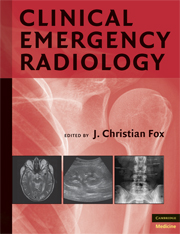Book contents
- Frontmatter
- Contents
- Contributors
- PART I PLAIN RADIOGRAPHY
- PART II ULTRASOUND
- PART III COMPUTED TOMOGRAPHY
- 28 CT in the ED: Special Considerations
- 29 CT of the Spine
- 30 CT Imaging of the Head
- 31 CT Imaging of the Face
- 32 CT of the Chest
- 33 CT of the Abdomen and Pelvis
- 34 CT Angiography of the Chest
- 35 CT Angiography of the Abdominal Vasculature
- 36 CT Angiography of the Head and Neck
- 37 CT Angiography of the Extremities
- PART IV MAGNETIC RESONANCE IMAGING
- Index
- Plate Section
36 - CT Angiography of the Head and Neck
from PART III - COMPUTED TOMOGRAPHY
Published online by Cambridge University Press: 07 December 2009
- Frontmatter
- Contents
- Contributors
- PART I PLAIN RADIOGRAPHY
- PART II ULTRASOUND
- PART III COMPUTED TOMOGRAPHY
- 28 CT in the ED: Special Considerations
- 29 CT of the Spine
- 30 CT Imaging of the Head
- 31 CT Imaging of the Face
- 32 CT of the Chest
- 33 CT of the Abdomen and Pelvis
- 34 CT Angiography of the Chest
- 35 CT Angiography of the Abdominal Vasculature
- 36 CT Angiography of the Head and Neck
- 37 CT Angiography of the Extremities
- PART IV MAGNETIC RESONANCE IMAGING
- Index
- Plate Section
Summary
Noninvasive imaging techniques are playing an ever-increasing role in the diagnosis and management of patients with lesions of the vascular structures of the head and neck. In addition to identifying the site and severity of stenosis, occlusion, or trauma, imaging of the vasculature of the head and neck can provide vital information regarding tissue injury and perfusion (location, size, and degree of reversibility or hypoperfusion). The choice of the imaging test depends on patient characteristics, the disease condition, the availability of technique and equipment, and the preference of the interpreting physician. Increasingly, CT angiography (CTA) and magnetic resonance angiography (MRA) are replacing digital subtraction angiography (DSA) in the evaluation of cervicocranial vascular disorders. Evaluation of many vascular disorders is easily accomplished by either MRA or CTA, and the choice between the two may well rest on the availability of equipment or the preference of the interpreter. In many instances, DSA may be reserved for occasions when CTA/MRA findings are equivocal or not consistent with clinical symptoms. In the case of CTA, the rapid availability of information allows the astute physician to triage patients to appropriate therapies quickly, when the opportunity to treat patients with salvageable tissue who may benefit most from acute therapies is greatest.
- Type
- Chapter
- Information
- Clinical Emergency Radiology , pp. 497 - 505Publisher: Cambridge University PressPrint publication year: 2008

